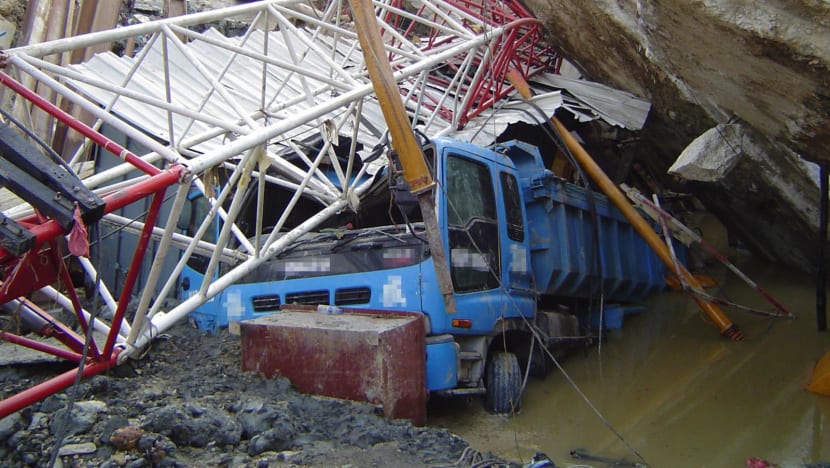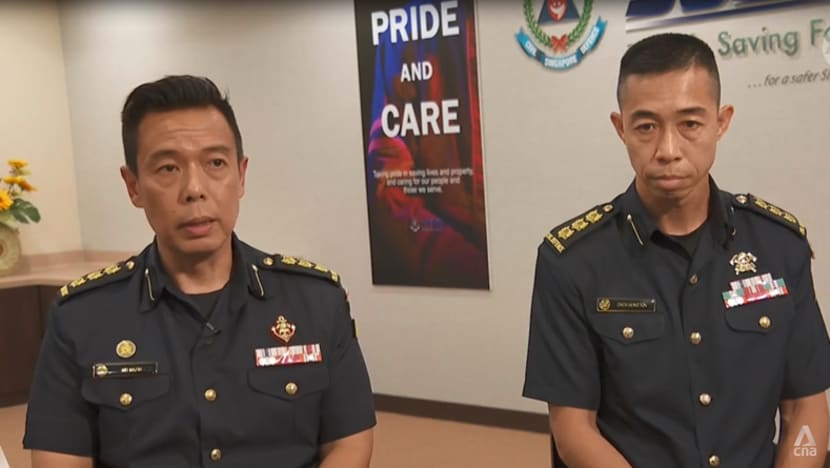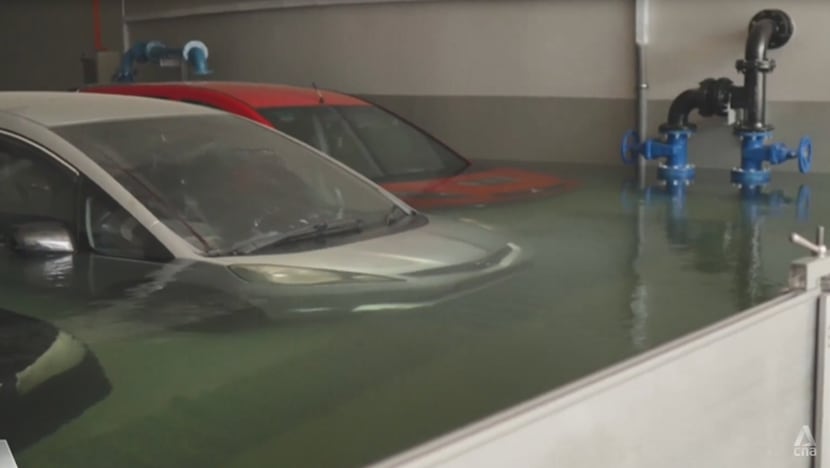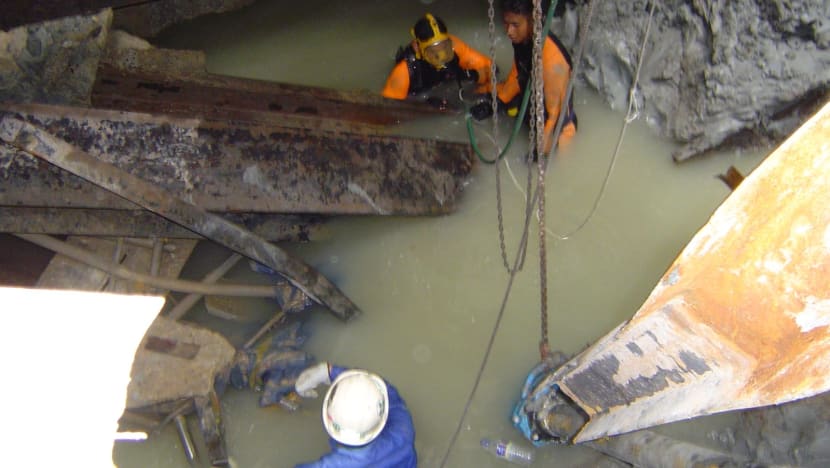SINGAPORE: Just before 4pm on Apr 20, 2004, Colonel Mohamed Nazim – then a young officer – noticed communication lines in his unit ringing off the hook.
Soon, the news came – a portion of the Nicoll Highway had collapsed.
Col Nazim was activated, and he sped to the site of the incident in his emergency response vehicle, picking up Col Chew Keng Tok on the way.
On route, the officers from the Singapore Civil Defence Force’s (SCDF) elite Disaster Assistance and Rescue Team (DART) planned on actions to take – but the site of the incident was more severe and chaotic than both men thought.
A deep ravine, caused when a temporary retaining wall of the tunnel at the Nicoll Highway Circle Line MRT station construction site collapsed, greeted the officers.
“It was something which we never expected,” said Col Mohamed Nazim.
“A container office was meshed together with a crane boom and a tipper truck in the cave-in. Water was seeping in from Kallang Basin, and the water level was rising very fast,” recalled Col Chew.

A truck is seen in a cave-in at the scene of the Nicoll Highway collapse in April, 2004. (File Photo: SCDF Corporate Communications Department)
Construction workers at the scene told the officers that there were men in the container, which was rapidly filling with water.
Col Chew secured a 10m safety rope to himself and handed the other end to Col Nazim. Then, he plunged into the murky water.
“I managed to find my way into the container office. There were some air pockets that I could surface and do short dives inside the container. But I couldn't find anyone,” said Col Chew.
He expanded his search outside the container, where he found the first victim, pinned between the office and the truck, lifeless.
A second victim was trapped under the vehicle.
“It was a very unstable structure. I spent five hours in the water to extricate one victim because it was quite a complex and challenging rescue,” said Col Nazim.

Col Mohamed Nazim and Col Chew Keng Tok speak to CNA about their experiences during the Nicoll Highway collapse in 2004, and how the SCDF has evolved since then.
Back then, the unit did not have diving equipment, so the officers improvised with breathing apparatus.
They were among more than 160 SCDF rescuers working in shifts during the round-the-clock operation, which went on for four days.
The incident killed four workers, one of whom – foreman Heng Yeow Pheow – was never found.
“On day four, we were doing dives at the spot where Mr Heng was last seen – it was at a mangled stairway, we were trying to find a way (around the debris) and go further down. The staircase was said to be 30m and we were only at about 17m,” Col Chew recounted.
By midday, a heavy downpour caused water levels to rise and soil to loosen. Structures were also becoming increasingly unstable. The operation was called off.
“As a rescuer, being able to rescue lives is important for us. Even being able to recover a deceased person can give the family closure,” said Col Chew.
“If we could, we would have wanted to continue but … we recognise the hazards and danger.”
Col Nazim is the deputy director of training at SCDF’s Civil Defence Academy, while Col Chew is the commander of the 2nd SCDF Division.
Both men said the SCDF has evolved much from lessons learnt through the Nicoll Highway collapse two decades ago.
The incident prompted the introduction of advanced diving capabilities that have been regularly updated over the years.
“After the incident, we set up our very own diving unit. We started off with very basic diving equipment and today we have progressed into better equipment such as underwater search vehicles,” said Col Nazim.
Training has also greatly improved. The academy now has various facilities that can simulate real-life disasters and crises, and allow officers to train across various aspects, including underwater rescue.

This SCDF facility simulates scenarios where officers can learn how to free victims trapped in vehicles underwater.
Aside from better equipment and facilities, officers are also regularly deployed to help in overseas disasters and get first-hand experience on the ground.
“Definitely, our standard operating procedure has evolved since the Nicoll Highway incident,” said Col Nazim.
“One of our key (standard operating procedures) that we included is in terms of safety – in any major incident, we cannot be working alone. Teamwork and safety are very important to make any operation more successful.”

SCDF DART rescuers (top) in water rescue suits respond at the scene of the Nicoll Highway collapse in April, 2004. (File Photo: SCDF Corporate Communications Department)
The rescue operations two decades ago left painful memories, but both men still take lessons from the experience.
“It was so scary to go into the cave-in at 15m deep, not knowing what's going to happen next,” said Col Chew.
“The incident gave us a clear understanding of what it means being in the emergency service – we really need to be ready for any incident because nobody knows when they happen.
“Translating that into today, we are training our people to be ready and prepare to respond at any given moment. We are providing proper equipment and facilities, and good and sound training.
“The key takeaway is to make the SCDF a better force, and a better frontline and emergency response organisation.”
Continue reading...
Soon, the news came – a portion of the Nicoll Highway had collapsed.
Col Nazim was activated, and he sped to the site of the incident in his emergency response vehicle, picking up Col Chew Keng Tok on the way.
On route, the officers from the Singapore Civil Defence Force’s (SCDF) elite Disaster Assistance and Rescue Team (DART) planned on actions to take – but the site of the incident was more severe and chaotic than both men thought.
A deep ravine, caused when a temporary retaining wall of the tunnel at the Nicoll Highway Circle Line MRT station construction site collapsed, greeted the officers.
“It was something which we never expected,” said Col Mohamed Nazim.
“A container office was meshed together with a crane boom and a tipper truck in the cave-in. Water was seeping in from Kallang Basin, and the water level was rising very fast,” recalled Col Chew.

A truck is seen in a cave-in at the scene of the Nicoll Highway collapse in April, 2004. (File Photo: SCDF Corporate Communications Department)
Construction workers at the scene told the officers that there were men in the container, which was rapidly filling with water.
Col Chew secured a 10m safety rope to himself and handed the other end to Col Nazim. Then, he plunged into the murky water.
“I managed to find my way into the container office. There were some air pockets that I could surface and do short dives inside the container. But I couldn't find anyone,” said Col Chew.
He expanded his search outside the container, where he found the first victim, pinned between the office and the truck, lifeless.
A second victim was trapped under the vehicle.
“It was a very unstable structure. I spent five hours in the water to extricate one victim because it was quite a complex and challenging rescue,” said Col Nazim.

Col Mohamed Nazim and Col Chew Keng Tok speak to CNA about their experiences during the Nicoll Highway collapse in 2004, and how the SCDF has evolved since then.
Back then, the unit did not have diving equipment, so the officers improvised with breathing apparatus.
They were among more than 160 SCDF rescuers working in shifts during the round-the-clock operation, which went on for four days.
The incident killed four workers, one of whom – foreman Heng Yeow Pheow – was never found.
“On day four, we were doing dives at the spot where Mr Heng was last seen – it was at a mangled stairway, we were trying to find a way (around the debris) and go further down. The staircase was said to be 30m and we were only at about 17m,” Col Chew recounted.
By midday, a heavy downpour caused water levels to rise and soil to loosen. Structures were also becoming increasingly unstable. The operation was called off.
“As a rescuer, being able to rescue lives is important for us. Even being able to recover a deceased person can give the family closure,” said Col Chew.
“If we could, we would have wanted to continue but … we recognise the hazards and danger.”
SCDF’S EVOLUTION IN PAST 20 YEARS
Col Nazim is the deputy director of training at SCDF’s Civil Defence Academy, while Col Chew is the commander of the 2nd SCDF Division.
Both men said the SCDF has evolved much from lessons learnt through the Nicoll Highway collapse two decades ago.
The incident prompted the introduction of advanced diving capabilities that have been regularly updated over the years.
“After the incident, we set up our very own diving unit. We started off with very basic diving equipment and today we have progressed into better equipment such as underwater search vehicles,” said Col Nazim.
Training has also greatly improved. The academy now has various facilities that can simulate real-life disasters and crises, and allow officers to train across various aspects, including underwater rescue.

This SCDF facility simulates scenarios where officers can learn how to free victims trapped in vehicles underwater.
Aside from better equipment and facilities, officers are also regularly deployed to help in overseas disasters and get first-hand experience on the ground.
“Definitely, our standard operating procedure has evolved since the Nicoll Highway incident,” said Col Nazim.
“One of our key (standard operating procedures) that we included is in terms of safety – in any major incident, we cannot be working alone. Teamwork and safety are very important to make any operation more successful.”

SCDF DART rescuers (top) in water rescue suits respond at the scene of the Nicoll Highway collapse in April, 2004. (File Photo: SCDF Corporate Communications Department)
The rescue operations two decades ago left painful memories, but both men still take lessons from the experience.
“It was so scary to go into the cave-in at 15m deep, not knowing what's going to happen next,” said Col Chew.
“The incident gave us a clear understanding of what it means being in the emergency service – we really need to be ready for any incident because nobody knows when they happen.
“Translating that into today, we are training our people to be ready and prepare to respond at any given moment. We are providing proper equipment and facilities, and good and sound training.
“The key takeaway is to make the SCDF a better force, and a better frontline and emergency response organisation.”
Continue reading...


